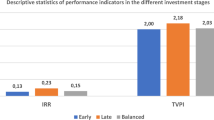Abstract
This paper investigates the reaction ofstock prices to enactment of the Private Securities LitigationReform Act of 1995 (PSLRA). Based on a sample of 489 high-technologyfirms, we find that the PSLRA was wealth-increasing, on average,and that the market reaction is more positive for firms at greatestrisk of being sued in a securities class action. However, wealso show that the PSLRA was less beneficial for firms likelyto be the subject of a meritorious lawsuit. Collectively, ourevidence implies that shareholders generally benefit from restrictionson private securities litigation, although these benefits aremitigated when other mechanisms for curbing fraudulent activityare inadequate.
Similar content being viewed by others
References
Alexander, J. C. (1991). “Do the Merits Matter? A Study of Settlements in Securities Class Actions.” Stanford Law Review 43, 497–598.
American Institute of Certified Public Accountants Committee of Sponsoring Organizations for the Treadway Commission. (1992). Internal Control—Integrated Framework. New York, NY: American Institute of Certified Public Accountants.
American Institute of Certified Public Accountants Special Committee on Financial Reporting. (1994). Improving Business Reporting—A Customer Focus: Meeting the Needs of Investors and Creditors. New York, NY
American Institute of Certified Public Accountants. Amihud, Y., and H. Mendelson. (1986). “Asset Pricing and the Bid-Ask Spread.” Journal of Financial Economics 17, 223–249.
Avery, J. (1996). “Securities Litigation Reform: The Long and Winding Road to the Private Securities Litigation Reform Act of 1995.” Business Lawyer 51, 335–378.
Beneish, M. (1999). “Incentives and Penalties Related to Earnings Overstatements that Violate GAAP.” The Accounting Review 74, 425–457.
Bonner, S., Z. Palmrose, and S. Young. (1998). “Fraud Type and Auditor Litigation: An Analysis of SEC Accounting and Auditing Enforcement Releases.” The Accounting Review 73, 503–532.
Botosan, C. (1997). “Disclosure Level and the Cost of Equity Capital.” The Accounting Review 72, 323–349.
Campbell, J., A. Lo, and A. C. MacKinley. (1997). The Econometrics of Financial Markets. Princeton, NJ: Princeton University Press.
Coffee, J. (1985). “The Unfaithful Champion: The Plaintiff as Monitor in Shareholder Litigation.” Law and Contemporary Problems 48, 5–81.
Coffee, J. (1996). “The Future of the Private Securities Litigation Reform Act: or,Why the Fat Lady Has Not Yet Sung.” Business Lawyer 51, 975–1007.
Conference Report, Private Securities Litigation Reform Act of 1995, H.R. Rep. No. 369, 104th Cong., 1st Sess., 141 Cong. Rec. H13699 (November 28, 1995).
Dechow, P., R. Sloan, and A. Sweeney. (1996). “Causes and Consequences of Earnings Manipulation: An Analysis of Firms Subject to Enforcement Actions by the SEC.” Contemporary Accounting Research 13, 1–36.
Easterbrook, F., and D. Fischel. (1985). “Optimal Damages in Securities Cases.” University of Chicago Law Review 52, 611–652.
Francis, J., D. Philbrick, and K. Schipper. (1994). “Determinants and Outcomes in Class Action Securities Litigation.” Working paper, University of Chicago.
Grundfest, J., and M. Perino. (1997). “Securities Litigation Reform: The First Year's Experience.” Working paper, Stanford University.
Johnson, M., R. Kasznik, and K. Nelson. (2000). “The Impact of Securities Litigation Reform on the Disclosure of Forward-Looking Information by High Technology Firms.” Journal of Accounting Research, forthcoming.
Jones, C., and S. Weingram. (1996). “The Determinants of 10b-5 Litigation Risk.” Working paper, Stanford University.
Kasznik, R., and B. Lev. (1995). “To Warn or Not to Warn: Management Disclosures in the Face of an Earnings Surprise.” The Accounting Review 70, 113–134.
Lang, M., and R. Lundholm. (1996). “Corporate Disclosure Policy and Analyst Behavior.” The Accounting Review 71, 467–492.
Levitt, A. (1998). “The Numbers Game.” Remarks delivered at the NYU Conference for Law and Business.
Lys, T., and R. Watts. (1994). “Lawsuits Against Auditors.” Journal of Accounting Research 32, 65–93.
National Association of Corporate Directors. (1996). Report of the NACD Blue Ribbon Commission on Director Professionalism. Washington D.C.: National Association of Corporate Directors.
National Journal's Congress Daily. (1995). “Clinton Officially Undecided on Securities Measure.” December 19.
Schipper, K., and R. Thompson. (1983). “The Impact of Merger-Related Regulation on the Shareholders of Acquiring Firms.” Journal of Accounting Research 21, 184–221.
Schneider, C., and J. Dubow. (1996). “Forward-Looking Information—Navigating in the Safe Harbor.” Business Lawyer 51, 1071–1100.
Sefcik, S., and R. Thompson. (1986). “An Approach to Statistical Inference in Cross-Sectional Models with Security Abnormal Returns as Dependent Variables.” Journal of Accounting Research 24, 316–334.
Skinner, D. (1996). “Why is Stockholder Litigation tied to Accounting and Disclosure Problems?” Unpublished manuscript, University of Michigan.
Spiess, D. K., and P. Tkac. (1997). “The Private Securities Litigation Reform Act of 1995: The Stock Market Casts its Vote.” Managerial and Decision Economics 18, 545–561.
Summers, S., and J. Sweeney. (1998). “Fraudulently Misstated Financial Statements and Insider Trader: An Empirical Analysis.” The Accounting Review 73, 131–146.
The Wall Street Journal. (1995a). “GOP-Controlled House Likely to Limit Investor Suits Against Public Companies.” January 20, C1.
The Wall Street Journal. (1995b). “Clinton Likely to Sign Suit Limits.” December 12, A3.
The Wall Street Journal. (1995c). “House Overrides Veto of Bill Curbing Securities Suits, but Senate Fight Looms.” December 21, A3.
The Washington Times. (1995). “Dining for Dollars at the White House.” December 19, A20.
Author information
Authors and Affiliations
Rights and permissions
About this article
Cite this article
Johnson, M.F., Kasznik, R. & Nelson, K.K. Shareholder Wealth Effects of the Private Securities Litigation Reform Act of 1995. Review of Accounting Studies 5, 217–233 (2000). https://doi.org/10.1023/A:1009612610389
Issue Date:
DOI: https://doi.org/10.1023/A:1009612610389




